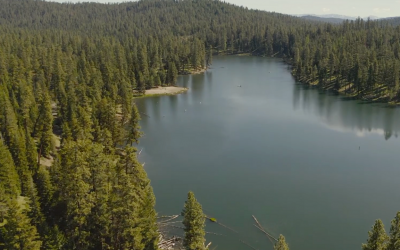Year after year, the question of purchasing a real versus artificial tree enters the homes of many. So which is the more sustainable option? The answer may surprise you!
Artificial Trees — Pros and Cons
At first glance, artificial trees seem like a sustainable choice. They are reusable and don’t require cutting down a living tree, but there are hidden factors that make artificial trees less sustainable than you’d think.
While artificial trees do have their pros — like cost efficiency, reusability and convenience — they actually have a high environmental impact. Environmental impact refers to the direct effects that activities and natural events have on the environment.
Other countries make most artificial trees and ship them to the United States. Because of this, the impact from transportation increases the environmental impact of artificial trees.
On the bright side, artificial trees can be used every year, so the longer you use your tree the more you offset its environmental impact! Unfortunately, they usually only last about 6 to 10 years, so they often end up in landfills before they can be considered sustainable.
So the question becomes, which is worse: cutting down a tree every year or throwing out a plastic tree every 6 to 10 years? Well, there’s a bit more to this story than that.
Harvesting Real Trees Sustainably
Would you believe us if we told you that cutting down a tree can actually be done sustainably? Well, believe it! Most holiday trees are harvested from tree farms where trees are grown for the sake of being cut down, kind of like a cornfield.
Real trees help the environment by cleaning the air, stabilizing the soil and providing a habitat for wildlife. Using this land for growing trees also prevents the land from being turned into a parking lot or shopping mall, while still giving back to the community and environment.
Tree farms plant at least one tree for each one sold, so you can be sure that the tree you take home is being replaced by a new one on the farm. These farms protect wild forests from unsustainable harvesting where there isn’t a guarantee that a new tree will be planted to replace a cut one.
Believe it or not, most national forests allow citizens to sustainably harvest trees from the forest. As long as citizens have a permit and follow the proper procedures and regulations, it’s totally sustainable!
The US Forest Service works with other organizations to properly reforest our national forests for future generations to enjoy. For more information on tree harvesting in national forests, go to the US Department of Agriculture website.
These are both great options to ensure the tree you are bringing into your home was grown and harvested sustainably!
Recycling Your Holiday Tree
So what do you do when it’s time to take down the decorations? Just like there are ways to harvest sustainably, there are plenty of ways to dispose of real trees sustainably too!
Since trees are biodegradable, meaning they naturally break down back into the environment, they can be recycled in many ways. Cut your tree into firewood or small coasters to be used at home, or have them recycled into the community.
Check to see if you live in an area that offers a free curbside pickup tree recycling service. Oftentimes cities and communities use the trees as mulch for public parks and other spaces. This fresh mulch helps enrich the soil and prevent erosion.
Some cities recycle trees back into the environment by laying them on the beach to help prevent erosion. They also might sink them into lakes and ponds to create fish habitats.
Unfortunately, once artificial trees end up in landfills they stay there forever because they aren’t biodegradable. Artificial trees are made with a material called polyvinyl chloride (PVC) which can contain lead and other harmful toxins. This material is not recyclable in most areas.
If your tree is still in good condition, donate it to a local church, library, business or school. If your tree has seen better days, use it in a craft such as a homemade wreath or garland. There are lots of sustainable options for continuing to reuse artificial trees.
Conclusion
When it comes down to naming the greener holiday tree, choosing a real versus artificial tree shines as the more eco-friendly option in the eyes of most experts when done properly. But remember, whichever tree you choose, there are ways to make it sustainable.
If you choose an artificial tree, buy American-made to reduce transportation impacts. And if you already have an artificial tree, keep using it for as long as you can! If you keep it long enough, you can lower the environmental impact to less than that of a natural tree.
If you’re picking out a real tree, harvest it sustainably from tree farms or through the US Forest Service. Don’t go out and cut down a tree without a proper permit.
And get creative with your recycling options! Happy holidays!



